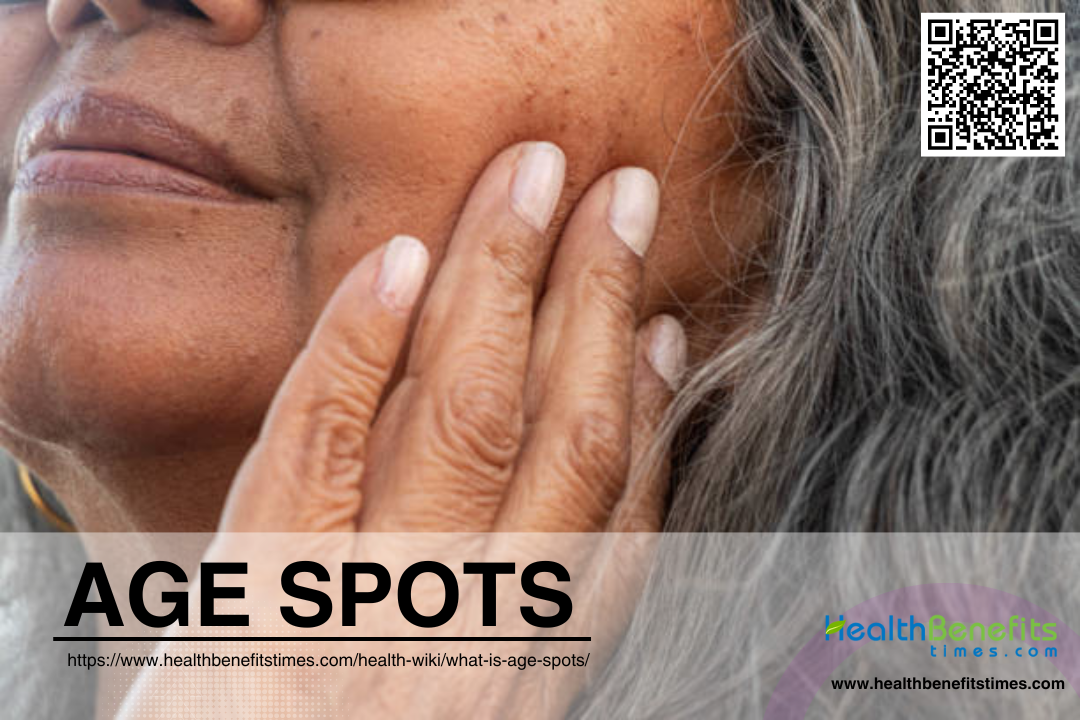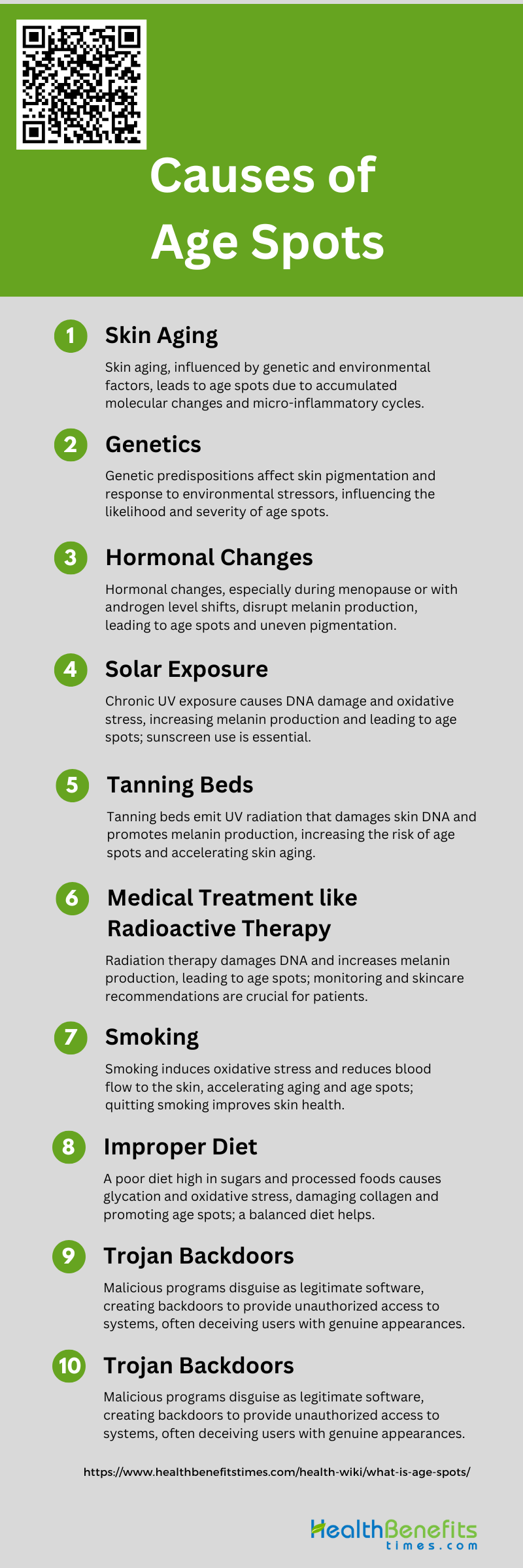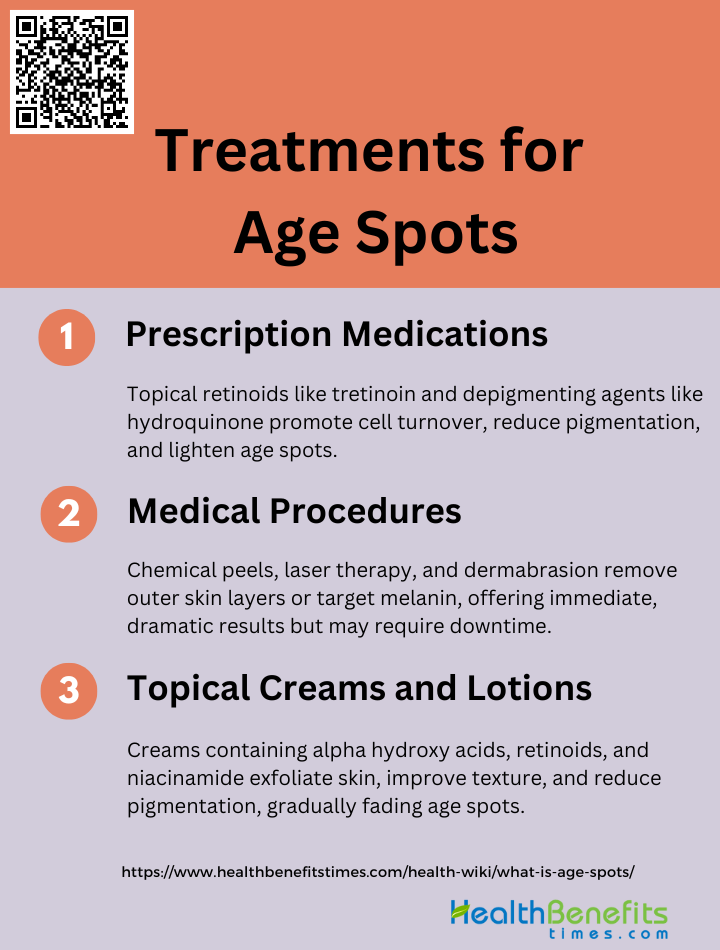 Age spots, also known as liver spots or solar lentigines, are flat, brown, gray, or black spots that appear on the skin, primarily in areas exposed to the sun. They are caused by an excess production of melanin, the pigment responsible for skin color, and are a result of prolonged exposure to ultraviolet (UV) radiation from the sun or tanning beds. Age spots are harmless and do not require medical treatment, but they can be a cosmetic concern for some individuals. They typically appear in people over 40 years old, especially those with fair skin and a history of frequent sun exposure.
Age spots, also known as liver spots or solar lentigines, are flat, brown, gray, or black spots that appear on the skin, primarily in areas exposed to the sun. They are caused by an excess production of melanin, the pigment responsible for skin color, and are a result of prolonged exposure to ultraviolet (UV) radiation from the sun or tanning beds. Age spots are harmless and do not require medical treatment, but they can be a cosmetic concern for some individuals. They typically appear in people over 40 years old, especially those with fair skin and a history of frequent sun exposure.
Characteristics of Age Spots
They can vary in color, ranging from light brown to black, and come in different sizes. These spots are associated with sun damage and have a higher risk of causing skin cancer. The formation of age spots involves intricate processes in the skin, including alterations in specific types of skin cells and the buildup of aged cells. Genetic factors also play a role, with variations in genes such as IRF4, MC1R, ASIP, and BNC2 influencing the prevalence of facial pigmented spots. As individuals age, they may notice an increase in age spots on their skin, which can differ in size and intensity of color. The morphological changes in aged skin, such as the flattening of the dermal/epidermal junction and alterations in collagen and elastic fibers, contribute to the overall appearance and characteristics of age spots.
Types of age spots
Below are two different types of age spots that one might encounter.
1. Senile Lentigines
Senile lentigines, commonly known as age spots or liver spots, are flat, tan, brown, or black spots that typically appear on sun-exposed areas of the skin, such as the face, hands, and arms. These spots are caused by an accumulation of pigment called melanin, which is produced by melanocytes (pigment-producing cells) in the skin. As we age, melanocytes become more active, leading to an increased production of melanin in certain areas, resulting in the formation of age spots. While harmless, these spots can be a cosmetic concern for some individuals, prompting them to seek treatment options.
2. Solaris Lentigines
Solaris lentigines, also known as sun-induced freckles or sun spots, are similar in appearance to age spots but are primarily caused by excessive exposure to ultraviolet (UV) radiation from the sun. These spots are typically larger and more irregular in shape than age spots, and they can appear on any area of the skin that has been exposed to the sun over an extended period. Unlike age spots, which are more common in older individuals, solaris lentigines can develop at any age, especially in those with fair skin types who spend a significant amount of time in the sun without proper protection.
Who is at risk for age spots?
As people get older, their risk of developing age spots increases. This is because the skin’s ability to repair itself decreases over time, causing a buildup of melanin and the formation of rete ridges in the top layer of skin. Changes in the structure and function of the skin, like a slower turnover of skin cells, also contribute to the development of these dark spots. Older adults, particularly those with a history of prolonged sun exposure, are at a higher risk for age spots.
Causes of Age Spots
Age spots are generally harmless, understanding their causes is essential for prevention and treatment. Here are the primary factors that contribute to the development of age spots:
1. Skin Aging
Skin aging is a complex process influenced by both intrinsic and extrinsic factors. Intrinsic aging, also known as chronological aging, is a natural process that occurs over time and is influenced by genetic factors and hormonal changes. Extrinsic aging, on the other hand, is primarily caused by environmental factors such as UV radiation, pollution, and lifestyle choices. The combination of these factors leads to various skin changes, including the formation of age spots, wrinkles, and loss of elasticity. The accumulation of molecular modifications and the activation of the micro-inflammatory cycle are key mechanisms in skin aging.
2. Genetics
Genetic factors play a significant role in the development of age spots. Variations in genes that regulate skin pigmentation, repair mechanisms, and cellular turnover can predispose individuals to age spots. For instance, genetic predisposition to higher melanin production can result in more pronounced pigmentation changes with age. Additionally, genetic factors influence the skin’s response to environmental stressors, such as UV radiation, which can exacerbate the formation of age spots.
3. Hormonal Changes
Hormonal changes, particularly those related to estrogen and testosterone, significantly impact skin aging and the development of age spots. In women, decreased estrogen levels during menopause can lead to reduced collagen production and skin elasticity, making the skin more susceptible to age spots. In men, changes in androgen levels can affect sebaceous gland activity and skin thickness, contributing to age-related pigmentation changes. Hormonal imbalances can disrupt the normal functioning of melanocytes, leading to uneven pigmentation and age spots.
4. Solar Exposure
Chronic exposure to solar ultraviolet (UV) radiation is a primary cause of age spots. UV radiation induces DNA damage, oxidative stress, and inflammation, leading to the activation of melanocytes and increased melanin production. This results in the formation of pigmented lesions, commonly known as age spots or solar lentigines. The cumulative effect of repeated UV exposure over time accelerates skin aging and the appearance of age spots. Protective measures such as sunscreen and sun avoidance are essential to mitigate the harmful effects of UV radiation.
5. Tanning Beds
The use of tanning beds, which emit artificial UV radiation, is another significant factor contributing to the development of age spots. Similar to natural sunlight, the UV radiation from tanning beds causes DNA damage and oxidative stress, leading to increased melanin production and the formation of pigmented lesions. The intensity and frequency of exposure to tanning beds can exacerbate skin aging and the appearance of age spots. Avoiding tanning beds and opting for safer alternatives like self-tanning products can help prevent these adverse effects.
6. Medical Treatment like Radioactive Therapy
Medical treatments such as radioactive therapy can also contribute to the formation of age spots. Radiation exposure can cause direct damage to the DNA of skin cells, leading to mutations and increased melanin production. This can result in the development of pigmented lesions and other skin changes associated with aging. Patients undergoing such treatments should be monitored for skin changes and provided with appropriate skincare recommendations to minimize the risk of age spots.
7. Smoking
Smoking is a well-known factor that accelerates skin aging and the development of age spots. The harmful chemicals in tobacco smoke induce oxidative stress, inflammation, and vascular changes, leading to skin damage and pigmentation changes. Smoking reduces blood flow to the skin, impairing its ability to repair and regenerate, which exacerbates the formation of age spots. Quitting smoking and adopting a healthy lifestyle can significantly improve skin health and reduce the risk of age spots.
8. Improper Diet
An improper diet lacking essential nutrients can negatively impact skin health and contribute to the development of age spots. Diets high in sugar and processed foods can lead to glycation, a process that damages collagen and elastin fibers, resulting in skin aging and pigmentation changes. Conversely, a diet rich in antioxidants, vitamins, and minerals can help protect the skin from oxidative stress and support its natural repair mechanisms. Maintaining a balanced diet is crucial for healthy, youthful-looking skin.
9. Bad Sleeping Habits
Poor sleeping habits can accelerate skin aging and the formation of age spots. Lack of sleep disrupts the body’s natural repair processes, leading to increased oxidative stress and inflammation. Chronic sleep deprivation can impair skin barrier function, reduce collagen production, and exacerbate pigmentation changes. Ensuring adequate and quality sleep is essential for maintaining healthy skin and preventing age spots.
10. Pollution
Exposure to environmental pollution, particularly airborne particles, is a significant factor in skin aging and the development of age spots. Pollutants such as particulate matter and soot can penetrate the skin, causing oxidative stress and inflammation. This leads to the activation of melanocytes and increased melanin production, resulting in pigmented lesions. Studies have shown a strong correlation between pollution exposure and the prevalence of age spots, highlighting the importance of protecting the skin from environmental pollutants.
Diagnosis for Age Spots
It’s important to distinguish them from more serious skin conditions. Here are the key steps typically involved in the diagnosis of age spots:
1. Visual inspection
During a visual inspection, a dermatologist will examine the size, color, and texture of the spots. They may use a dermatoscope, a handheld magnifying device, to get a closer look at the spots’ patterns and borders. This visual assessment helps differentiate age spots from other skin conditions like melanoma or seborrheic keratoses. The doctor may also inquire about the patient’s sun exposure history and any changes in the spots’ appearance.
2. Skin biopsy
In some cases, a skin biopsy may be recommended to rule out potential skin cancers or precancerous lesions. During a biopsy, a small sample of the affected skin is removed and sent to a laboratory for microscopic examination. This procedure is typically performed under local anesthesia and involves minimal discomfort. The biopsy results can provide valuable information about the cellular structure and composition of the spot, confirming or ruling out the presence of cancerous cells. If the biopsy reveals a concerning growth, further treatment options may be discussed with the patient.
Treatments for Age Spots
Below is a list of effective treatments that can help reduce the appearance of age spots.
1. Prescription Medications
Prescription medications for treating age spots primarily include topical retinoids such as tretinoin. Tretinoin, a form of vitamin A, has been shown to improve the appearance of aged skin by promoting cell turnover and reducing pigmentation. Studies have demonstrated that tretinoin can significantly reverse the clinical and histological changes associated with photodamage and chronological aging when used consistently over several months. Additionally, other prescription medications like hydroquinone, a depigmenting agent, are often used to lighten age spots by inhibiting melanin production. These treatments are generally effective but may cause mild irritation or other side effects.
2. Medical Procedures
Medical procedures for age spots include chemical peels, laser therapy, and dermabrasion. Chemical peels involve applying a chemical solution to the skin, which causes it to exfoliate and eventually peel off, revealing new, less pigmented skin underneath. Laser therapy uses focused light to target and break down melanin in age spots, leading to their gradual fading. Dermabrasion, a more invasive procedure, involves the mechanical removal of the outer skin layers to promote new skin growth. These procedures are typically performed by dermatologists and can offer more immediate and dramatic results compared to topical treatments, though they may require downtime and carry risks of complications.
3. Topical Creams and Lotions
Topical creams and lotions are widely used for the treatment of age spots and often contain ingredients like alpha hydroxy acids (AHAs), retinoids, and antioxidants. AHAs, such as glycolic acid, help to exfoliate the skin and promote cell turnover, which can reduce the appearance of age spots. Retinoids, including over-the-counter retinol, are also effective in improving skin texture and pigmentation. Additionally, products containing niacinamide (vitamin B3) have been shown to reduce hyperpigmentation and improve overall skin appearance. These topical treatments are generally well-tolerated and can be used as part of a daily skincare regimen to gradually improve the appearance of age spots.
Prevention of Age Spots
Here are list of effective strategies to help protect your skin and minimize the appearance of age spots.
1. Avoid the sun between 10 a.m. and 2 p.m.
Avoiding the sun during peak hours, typically between 10 a.m. and 2 p.m., is crucial for preventing age spots and other forms of skin damage. During these hours, the sun’s ultraviolet (UV) radiation is at its strongest, significantly increasing the risk of photoaging and skin cancer. Studies have shown that limiting sun exposure during these peak times can reduce the incidence of skin damage and the formation of age spots. By staying indoors or seeking shade during these hours, individuals can protect their skin from the harmful effects of UV radiation, thereby maintaining healthier and younger-looking skin.
2. Use sunscreen
Using sunscreen is one of the most effective measures to prevent age spots and other signs of photoaging. Sunscreens with a high Sun Protection Factor (SPF) can block or absorb harmful UV radiation, thereby minimizing skin damage. It is recommended to use broad-spectrum sunscreens that protect against both UVA and UVB rays, as both types contribute to skin aging and the formation of age spots. Regular and proper application of sunscreen, especially during prolonged outdoor activities, can significantly reduce the risk of developing age spots and other skin conditions associated with sun exposure.
3. Cover up
Wearing protective clothing is another essential strategy for preventing age spots. Clothing such as long sleeves, wide-brimmed hats, and sunglasses can provide a physical barrier against UV radiation, thereby reducing skin exposure to harmful rays. Studies emphasize the importance of photoprotective clothing in conjunction with other sun protection measures like sunscreen and sun avoidance during peak hours. By covering up, individuals can further shield their skin from the damaging effects of the sun, thereby preventing the formation of age spots and maintaining overall skin health.



